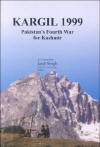|
| Home | About Kashmir Herald | |
Volume 2, No. 1 - June 2002 |
|
|
|
Lashkar-e-Jabbar (LJ) The existence of Lashkar-e-Jabbar (LJ) was first reported by the local media in Jammu and Kashmir in August 2001 following two incidents. In the first incident, two unidentified youth poured diluted acid on two school teachers in the Khanyar area of Srinagar on August 7. The next day, an armed terrorist threatened all students and teachers of a girls school in Srinagar of violence unless they adopt ‘Islamic’ dress codes. Following these, an unidentified person is reported to have informed the local media in Srinagar that his outfit, the Lashkar-e-Jabbar was responsible for these attacks. He added that the outfit meant "business in implementing the Islamic dress code in Kashmir". According to their interpretations, Muslim women must always wear the burqa in public. News reports in the aftermath of this information have also claimed that these attacks were preceded by isolated incidents of firing by unidentified terrorists on unveiled women in south Kashmir in the past two months which left three women injured. Following this, the outfit was also reported as having fixed September 1, as the deadline for acceptance of its dress codes. The abrupt resurgence of this issue prompted an older outfit, Dukhtaran-e-Millat (DeM), which too projects identical goals, to join the ‘movement’. Supporting the LJ’s demands, the DeM appealed to the former for a postponement in the deadline. The LJ responded promptly by postponing the deadline to September 10. Meanwhile, the outfit also released a statement on September 8, asking non-Muslim women to wear identifying marks such as ‘bindis’ on their foreheads or saffron duppatas or to dress in yellow clothes. Though these developments found little attention in the mainstream press, the impact of the LJ’s orders were effective with newspapers reporting a major scramble among Muslim women to get burqas stitched as also brisk sales of black fabric. A news report on September 9 also claimed that about 30 per cent of working women in the State’s major towns were seen using burqas as compared to an estimated five per cent who used these before the LJ’s announcement. In the light of such a response, the outfit also added a new order that all public transport vehicles must have half a section reserved for women to ensure that there is complete segregation between male and female passengers. For an outfit that has cornered publicity on a large scale, little is known of its origin or character. There has only been speculation. Some news reports speculate that it is a creation of the DeM, which had failed in the early Nineties when it attempted to force women to accept Islamic dress codes. Another news report claiming to cite intelligence reports submitted to the Prime Minister said that the outfit was promoted by other terrorist outfits to make the use of burqas widespread and consequently to use these for launching attacks on security forces. These intelligence reports have reportedly added that Lashkar-e-Jabbar was also receiving overt and covert support from the Pakistan-based Haqqania Madrassa, which in turn was funded by wealthy Pakistanis and other Muslims living in West Asian countries. The Haqqania Madrassa is also reported to have secured support from the Saudi terrorist, Osama bin Laden, currently based in Afghanistan. Laden is also suspected to be aiding the Lashkar-e-Jabbar. Most terrorists outfits active in the State, including the Hizb-ul-Mujahideen (HM) and the Lashkar-e-Toiba (LeT) have reportedly condemned the outfit. While the LeT, on August 12, claimed that the aim of those involved in such activities is to malign the outfit (LeT), the Hizb, on the same day, claimed that there was no terrorist outfit existing in the name of Lashkar-e-Jabbar and the activities being carried out in their name signified a deep conspiracy against the ‘Kashmiri freedom movement’. Softening this stance, the Hizb, on September 10 released a statement saying that the LJ will be seen as a ‘suspect group’ until it is proven that it is part of the ‘Jihadi movement’ in Jammu and Kashmir. Another terrorist outfit, the Jamiat-ul-Mujahideen (JuM), which first criticized the LJ, later changed its stance on September 10, and welcomed the outfit's activities. The All Party Hurriyat Conference (APHC) too has condemned the use of coercive measures to implement ‘Islamic values’. Several other Islamic organisations in the State are also reported to have denounced the "coercive tactics" to make women wear veil, by saying that Islam does not permit any use of force to implement dress codes. These organisations include Jamiat-Ulema Hind, Jamiat-e-Islami Hind and the All India Muslim Majlis-e-Mushawarat. Security force sources, meanwhile, were cited by news reports on September 10 as saying that patrol and deployment of plainclothesmen were being increased in view of the Lashkar-e-Jabbar’s threat. The State Chief Minister Farooq Abdullah was also reported to have taken a serious note of the Lashkar-e-Jabbar threats and has warned police officials that they would be liable to action in case any incident of acid-throwing occurred in their jurisdiction. State security officials were also reported as considering the option of a massive crackdown on the DeM, in view of the suspected links between the two outfits. Courtesy: |
 |
 |
 |
|
| Archives
| Privacy Policy |
Copyrights
| Contact
Us | |
||